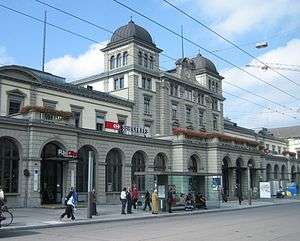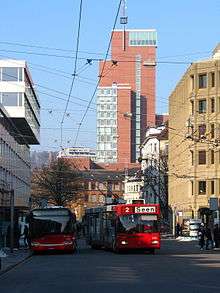Winterthur railway station
Winterthur railway station (German: Bahnhof Winterthur or Hauptbahnhof Winterthur) is the principal railway station of Winterthur, in the Swiss canton of Zürich.[2][3] The station is listed on the Swiss Inventory of Cultural Property of National Significance.[4]
Winterthur | |
|---|---|
 The station frontage in 2008 | |
| Location | Bahnhofplatz 5–9 Winterthur Switzerland |
| Coordinates | 47°30′1.18″N 8°43′25.63″E |
| Elevation | 438 m (1,437 ft) |
| Owned by | Swiss Federal Railways |
| Line(s) |
|
| Platforms | 6 |
| Tracks | 9 |
| Train operators | |
| Connections | PostAuto and local buses |
| Construction | |
| Architect |
|
| Architectural style | 1896: Neorenaissance |
| Other information | |
| Fare zone | ZVV: 120 |
| Website | Bahnhof Winterthur |
| History | |
| Opened |
|
| Rebuilt |
|
| Traffic | |
| Passengers (2018) | 109,300 per working day[1] |
| Rank | 4 of 1735 |
| Services | |
| Location | |
 Winterthur Location within Switzerland | |
Winterthur is Switzerland's fifth busiest station,[5] and is a major node between Switzerland's largest railway nucleus in Zürich and places in Eastern Switzerland (such as St. Gallen and Schaffhausen), as well as Germany (Munich), and Austria (Vorarlberg). The station is served by trains on Zürich's suburban S-Bahn network, as well as by regional and intercity trains, with all through passenger trains making a stop. It is directly linked to Zürich Flughafen – Zurich Airport's railway station – within 15 minutes travelling time seven times per hour. Zürich Hauptbahnhof can be reached with up to 16 direct connections per hour, the fastest of which takes 22 minutes. The station has 9 standard gauge platforms and is the central node of the local STADTBUS Winterthur network and regional bus services (e.g. PostBus Switzerland). All public transport in and around Winterthur is part of the canton of Zürich's integrated fare network ZVV.
Location
Bahnhof Winterthur is centrally located, at the northwestern edge of the city centre.
History
In 1855, the first temporary station building was built in Winterthur as a timber framed structure. The design of the building was by A. Beck, who also managed the construction. The building was sold in 1860 to the City of Zurich, which wanted to move and rebuild it in the vicinity of the Kornhaus. Most likely, it was used for the construction of the Kornhauswirtschaft, as these two buildings bear a very great resemblance.[6]

Five years after the opening of the provisional building, the first real station was built, under the direction of the architect Jakob Friedrich Wanner, who, together with A. Beck, was responsible for the design. The builder, Meier, came from Winterthur, and the train shed was built by the firm Benkiser of Pforzheim.[7] In 1875, its first expansion was completed, to coincide with the commencement of the Winterthur operations of the Tösstalbahn and the Nationalbahn. This expansion consisted of an extension to each side of the station building equal to the width of four window bays, in order to create space for new waiting rooms.
Further renovations in 1894−96 left the station building in its present form. These renovations, proposed by the architect Ernst Jung and Otto Bridler, produced a station building in Renaissance style; the Federal Palace of Switzerland served as a template.
In 1944, the present day tracks 8 and 9 were added. In 1980, the station was again extended by two tracks (the current platforms 1 and 2), which were used for the Tösstal line and for postal trains. Today, S-Bahn trains to Wil depart from the Postal train track.
In 1988, the two-storey parking deck was built over the station yard. In 2000 followed the construction of the Stadttor Winterthur between the station building and the EPA department store, which is now a Coop City department store.
The term Hauptbahnhof or HB (for main railway station) is no longer used by Swiss Federal Railways (SBB CFF FFS), the station's owner and operator, but is still sometimes used colloquially. Although the station's name appears simply as Winterthur on the station signs and on schedule information, the name Hauptbahnhof is still used for the bus stop in front of the station.
Tracks
Winterthur is a through station with nine tracks, of which only tracks 1 and 2 are bay platforms. From those two platforms, S-Bahn trains depart for the Tösstal and to Wil. Long distance trains stop at tracks 3, 4 and 5, which are the ones closest to the station concourse.
In front of the station, on the line towards Zurich, is the former goods station. It was closed in 1995/1996, and serves today only for the storage of trains. As a replacement for the closed structure, a maintenance facility was built at the Oberwinterthur railway station.
Long distance services
The following regularly scheduled long distance trains stop at Winterthur:[8]
- EuroCity: three round-trips per day between Zürich Hauptbahnhof and München Hauptbahnhof, with one train continuing from Zürich to Basel SBB.
- InterCity:
- hourly service between Geneva Airport and St. Gallen.
- hourly service between Lausanne and St. Gallen.
- hourly service between Brig and Romanshorn.
- InterRegio:
Local services
Zürich S-Bahn
The following S-Bahn lines, all of which belong to the Zürcher Verkehrsverbund, serve Winterthur.[9] While the lines with the lower numbers are operated by the SBB CFF FFS, the trains with the higher numbers (from S26) are operated by THURBO.
- S7 Winterthur – Kloten – Hardbrücke – Zürich HB – Meilen – Rapperswil
Operates non stop between Stadelhofen and Meilen. - S8 Winterthur – Wallisellen – Oerlikon – Zürich HB – Thalwil – Pfäffikon SZ (– Ziegelbrücke)
Operates non stop between Winterthur and Effretikon; first and last services extended to Ziegelbrücke. - S11 (Aarau – Lenzburg –) Dietikon – Zürich HB – Zürich Stettbach – Winterthur – Seuzach / Sennhof-Kyburg (– Wila)
Operates non stop between Stettbach and Winterthur; the lines to Seuzach and Sennhof-Kybourg are operated alternately at hourly intervals; supplementary trains to Wila. - S12 Brugg AG – Zürich HB – Zürich Stettbach – Winterthur – Schaffhausen / Wil SG
Operates non stop between Stettbach and Winterthur; the lines to Schaffhausen and Wil SG are operated alternately at hourly intervals. - S24 Thayngen / Weinfelden – Winterthur – Zürich Flughafen – Wipkingen – Zürich HB – Thalwil – Zug
Operates non stop between Winterthur and Effretikon; the lines to Thayngen and Weinfelden are operated alternately at hourly intervals; stops between Neuhausen and Winterthur only in Andelfingen. - S26 Winterthur – Bauma (– Rüti ZH)
Operates only on weekends to Rapperswil. - S29 Winterthur – Stein am Rhein
- S30 Winterthur – Frauenfeld – Weinfelden (– Romanshorn – Rorschach)
- S33 Winterthur – Andelfingen – Schaffhausen
- S35 Winterthur – Wil SG
- S41 Winterthur – Bülach
Night trains
Winterthur is a terminus of five night trains, two of which are part of the Zürich S-Bahn network. The other three belong to the "THURBO-Nightliner" system. Line SN4 of the Zürich S-Bahn is also operated by THURBO and belongs simultaneously to the THURBO-Nightliners.
- SN1 Winterthur – Zürich HB – Dietikon – Lenzburg (– Aarau)
- SN4 Winterthur – Schaffhausen (– Stein am Rhein – Konstanz (D) - Kreuzlingen - Romanshorn)
- SN Winterthur – Romanshorn ((– Konstanz (D)) - Kreuzlingen)
- SN Winterthur – Wil SG – St. Gallen
- SN Winterthur – Bülach
Urban public transport
Winterthur Hauptbahnhof or HB is the central bus station of the local STADTBUS Winterthur bus operator and therefore also the most important hub of the Winterthur trolleybus system. All but two of the city bus lines stop at the Hauptbahnhof. Additionally, the regional Stadtbus lines, along with PostAuto lines, all stop there. Only the lines that serve Wiesendangen and a few villages northeast of Winterthur depart from Oberwinterthur station instead. The Winterthur bus station is the largest in the canton of Zurich.
Stadtbus Winterthur

Lines 1–3 are trolleybus lines. The remaining lines are operated exclusively by low-floor buses. Normally, articulated buses run on lines 5, 7 and 14. On the remaining lines, conventional (rigid chassis) buses provide the services.
| Line | Route |
|---|---|
| 1 | Töss – HB – Oberwinterthur |
| 2 | Wülflingen – HB – Seen |
| 3 | Rosenberg – HB – Oberseen |
| 4 | HB – Breite – HB (circle route) |
| 5 | Technorama – HB – Dättnau |
| 7 | HB – Schlosstal – Bhf. Wülflingen |
| 10 | HB – Bhf. Oberwinterthur |
| 11 | HB – Steig |
| 12 | HB – Bruderhaus – HB |
| 14 | HB – Bhf. Hegi |
| HB – Oskar Reinhart "am Römerholz" (Museum bus; Taxi line) |
Regional lines
The yellow numbers are PostAuto lines, and the blue numbers are city bus lines. However, lines 665/670 are served by both PostAuto buses and city buses.
| Line | Route |
|---|---|
| 660 | HB – Brütten – Nürensdorf – Bassersdorf (- Flughafen) |
| 767 | (HB –) Brütten – Breite – Nürensdorf – Bassersdorf – Flughafen Kloten |
| 665 | HB – Neftenbach – Dättlikon |
| 670 | HB – Neftenbach – Berg am Irchel – Flaach – Rafz |
| 674 | HB - Rosenberg - Seuzach |
| 676 | HB – Rutschwil – Henggart |
| 680 | HB – Elsau – Schlatt – Elgg/Girenbad b. Turbenthal |
Night buses
Night buses operate hourly on Friday to Saturday and Saturday to Sunday from 01:30 to 04:30. As the last regular buses usually depart from HB at 0.50 and the first such buses start running again from 05:30, one can therefore speak of a continuously operating network when the night buses are running.
The night buses operate on the following lines, but only outwards; there are no return services.
| Line | Route |
|---|---|
| N59 | HB – Strochenbrücke – Schlosstal - Niederfeld - Bahnhof Wülflingen |
| N60 | HB – Oberwinterthur – Seuzach - Adlikon bei Andelfingen (Postauto) |
| N61 | HB – Hegi – Elsau - Wiesendangen - Sulz - Rickenbach – Ellikon - Altikon – Thalheim - Dinhard - Welsikon |
| N64 | HB – Rosenberg – Seuzach – Flaach – Buch am Irchel - Riedt bei Neftenbach (Postauto) |
| N65 | HB – Waldheim – Eishalle – Oberseen |
| N66 | HB – Töss – Brütten – Nürensdorf - Bassersdorf – Lindau - Kemptthal |
| N67 | HB – Wülflingen – Neftenbach – Pfungen – Dättlikon |
| N68 | HB – Seen – Zell – Turbenthal – Wila (Postauto) |
Panorama
References
- "Passagierfrequenz (2018)". Berne, Switzerland: SBB CFF FFS. 7 October 2019. Retrieved 2019-11-06 – via data.sbb.ch – SBB DATA PORTAL.
- map.geo.admin.ch (Map). Swiss Confederation. Retrieved 2011-12-02.
- Eisenbahnatlas Schweiz. Verlag Schweers + Wall GmbH. 2012. pp. 12–13. ISBN 978-3-89494-130-7.
- "Schweizerisches Inventar der Kulturgüter von nationaler Bedeutung - Zürich" [Swiss Inventory of Cultural Property of National Significance - Zurich] (PDF) (in German). Swiss Confederation. 2011. Retrieved 2011-09-13.
- "Bahnhöfe" [Railway Stations] (in German). Swiss Federal Railway. 2018. Retrieved 2019-03-25.
- Stutz 1976, p. 110
- Stutz 1976, p. 152
- "Abfahrt: Bahnhof Winterthur" (PDF). Swiss Federal Railways (in German). 15 December 2019. Retrieved 31 May 2020.
- "S-Bahn trains, buses and boats" (PDF). ZVV. 9 December 2018. Retrieved 21 September 2019.
Cited works
- Stutz, Werner (1976). Bahnhöfe der Schweiz [Railway Stations of Switzerland] (in German). Zürich: Verlag Berichthaus. ISBN 3-85572-018-5.
